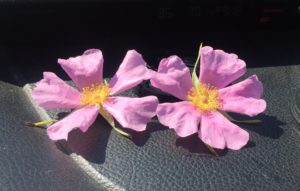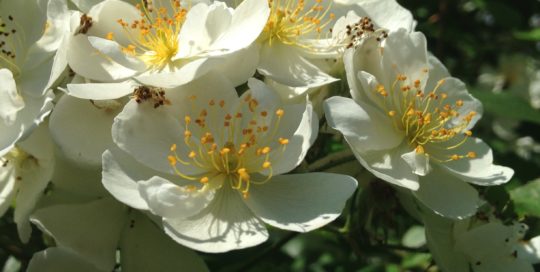Native Species Roses in the Northeast
Views: 700

A road much travelled
Hundreds and hundreds of cars and trucks pass by the stretch of road daily. They have been doing this for decades and decades. It has been the main road to my workplace for some 30+ years. The people driving and riding in these vehicles see houses and birds and trees and fences and any number of items normally found on the secondary roads of rural America. I often wonder how many of them realize that there are also beautiful (and fragrant) roses growing in the landscape as well?
What’s growing along the roadway
For the past dozen years or so, I have been infatuated with the natural wonders that Mother Nature has set forth in her hybrid roses. Native beauties such as R. arkansana, R. carolina, R. nitida, R. palustris, R. virginiana, as well as other native and alien species can be found throughout the well-travelled roadway.
It often amazes me as to how some of these beauties are not only able to survive but thrive despite the harsh conditions that they forced to endure. As time and opportunity allow, I stop by to see the various roses as they bloom along this 5-6 mile stretch of road that I use daily. Accessibility to these roses varies depending on where they were able to set forth their roots and conquer the environment that Mother Nature has given them.
Access to the roses
I have been able to access most of the roses that I have seen growing along the roadside. However, my knees get less flexible as I age. I get more limited in my ability to climb up and down the steeper embankments and deeper ditches. One particular grouping of R. palustris has always been totally inaccessible to me. In addition to being down a steep incline, this particular site is located in a swamp, and the roses are 15-20 feet away from the edge on small islands. There is no easy way to access these small islands, and the roses must be enjoyed from afar.
Visiting the roses
This season, I stopped to see some of the native species roses to see how they are doing and to take a picture (or two) for this blog. I wasn’t able to see the R. arkansana from the road (which I could do a few years ago) and found out that the rose is now hidden behind a Jersey barrier. The day I visited the rose, it was almost done blooming, and the spent blooms were not worth the effort to photograph.
R. nitida was not in bloom when I stopped by a week or so later. The morning that I stopped, I was late for work, and temperatures were in the 80’s. The rose is down a steep incline, and I decided it wasn’t worth the effort to see why they weren’t in bloom.
Life got in the way this year for visiting many of the native species roses along the roadway. Unfortunately, I missed these opportunities and will have to wait until another time to see these roses blooming in their natural surroundings.
Visiting the inaccessible Palustris
That same day that I stopped by to see the R. nitida, I decided to check to see at what stage of bloom the inaccessible Palustris was at on my way home from work. I know that it usually blooms in or around July 4th. I use the holiday as a guide to direct me to when the roses are in bloom.
It was June 29th, and almost all of the roses here in Southern New England are blooming a little earlier this year. I stopped the car at the site and took a walk down to the edge of the swamp. The skies were turning grey as a thunderstorm was coming through. I could see that there were many roses that had opened up earlier in the day, but they were now closed. With the looming grey skies and nightfall coming soon, they were waiting until morning to reopen. I decided to revisit them in the morning.
Revisiting the inaccessible Palustris
The next morning I arrived at the site mid-morning. It was in the 80’s again. I took my big black SLR camera and went down the embankment to take pictures. I could see many roses blooming in the distance. The lens that was on my camera was the standard lens, and the pictures that I took didn’t show enough detail. I decided to go and get the zoom lens from my camera bag to get better pictures.
After I got some decent pictures, when was leaving, I could see one plant in bloom that I hadn’t noticed before on the same side of the swamp as me. It was the first time I was able to access these plants and take the closeup pictures that I wanted. I picked two of the blooms, put them on my dashboard of my car, and took a couple of pictures with my cell phone.
Of all of the pictures I took of R. palustris that morning, the ones taken by my cell phone of the blooms in my car were actually the ones I liked best. This year, I was finally able to see and smell the inaccessible R. palustris in the swamp!
Differentiating the different species
The different native species often bloom at different times in our area during late spring/early summer. R. arkansana and R. carolina are among the earliest bloom, while R. palustris is among the last to bloom. Many of these roses from the Cinnamomeae section of roses often look the same or very similar as far as the bloom goes, which doesn’t make identifying them easy. There also can be different individual characteristics of the same species that vary from plant to plant. This adds additional difficulty in identifying them. But, other characteristics such as foliage, plant size, etc. can be quite different as one studies them more closely. These secondary characteristics can be very helpful in getting the plants identified.
Where do the roses grow?
One of the major factors in determining native species is where they are found growing. We may put any rose we may want to grow in our cultivated gardens. Without too much effort, they will thrive. Mother Nature gravitates particular species towards different growing conditions, and these conditions are usually centered around the availability of water. Roses such as R. nitida, R. virginiana, and R. palustris, tend to be found closer to sources of water than R. carolina and R. arkansana. That doesn’t mean that any and all of these roses can’t be found under different growing conditions other than the one that Mother Nature usually prefers.
How I grow my native species roses
I have taken some of these native beauties as runners and seeds to grown them in containers in my yard. I keep them in containers instead of planting them in the ground, because many of them do tend to send out many suckers/runners, and I do not want these runners taking over the other roses in my garden. The containers that I have most of them in, tend to be are quite large (8-10 gallon). I let them run free in the containers, and when they try to escape through holes in the sides and bottoms of the containers, I can easily stop them without too much difficulty.
Winter protection
Winter protection is something that I do not provide for my species roses. I put the containers in a secluded area by the Quonset Hut, and that’s it. The soil does freeze in the containers. By spring after they thaw, I put the roses out with my other containerized roses. I have not lost any native species roses this way. I fertilize them lightly as I do not want them to become too large. Also, I thin them out regularly as the number of suckers in the containers increases and become too crowded.
Fragrance
Fragrance abounds in many species roses. It is one of my favorite things about them. The local bee population always seem to find my containerized species roses to collect pollen. The intoxicating fragrances help the bees find their way. I do not spray pesticides on any species roses that I grow. They need to fend for themselves, just as Mother Nature intended. They do get some anthracnose during the warmest part of the summer. However, they are not bothered by it and just keep on going in spite of it. In general, my species roses are the healthiest roses in my garden.
Native species roses in America
Native species roses can be found growing throughout the 48 contiguous states and Alaska. They thrive in some of the most inhospitable climates – from the desert of California (R. minutifolia) to the severe winter colds of the Arctic Circle (R. acicularis). Most are once-blooming and have five petals.
The oldest roses ever found
Wild roses have been growing on the continent for over 35 million years. People found the oldest roses ever in the fossil record in parts of Colorado and Oregon. Scientists have named the three roses that were found in Colorado and Oregon as three individual species. However, it is highly likely that they are all the same species comparable to R. nutkana that can be found growing in the region today. There is an article in the 1942 The American Rose Annual by Charles E. Resser, Curator of Stratigraphic Paleontology, U. S. National Museum in Washington, D.C. about these very old American species roses.
My species rose collection
My personal collection of species roses stands at ten different species. I hope to add more as they become available to me. Plus, I have entered many of these roses in the local rose shows, and received many Genesis Certificates with them. I have even won the Yankee District Mike Lowe Memorial Trophy for Old Garden Roses with an entry of three different species roses.
It’s amazing what Mother Nature has done with her species roses through the millennia. I embrace her work with great enthusiasm. Hopefully, you will get a chance to see what’s growing in your neck of the woods as well. I’m sure that you can find some of her special hybrid roses as well.
Epilogue
I originally composed this story on my green faux marble Watermans fountain pen. It is the first story in a series I will be having about found roses. Species roses are the original found roses discovered by man. While many people use species roses to create the modern wonders we enjoy in our gardens today, people largely ignore the American species roses. Work is underway to get more genes from the American species into the modern gene pool, and who knows? The key to conquering the dreaded rose rosette disease (and other diseases) may lie within these under-utilized species?
Meet Andy Vanable
Andy's Recent Posts

The Rose-Growing World Loses an Icon – Bob Martin






